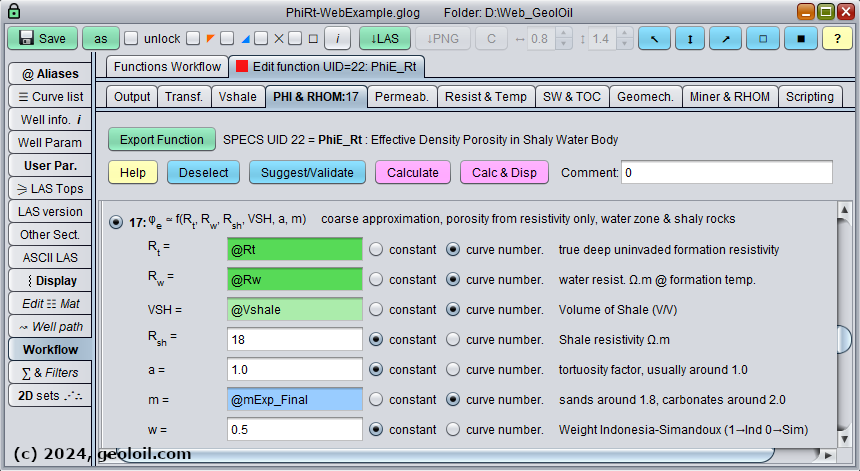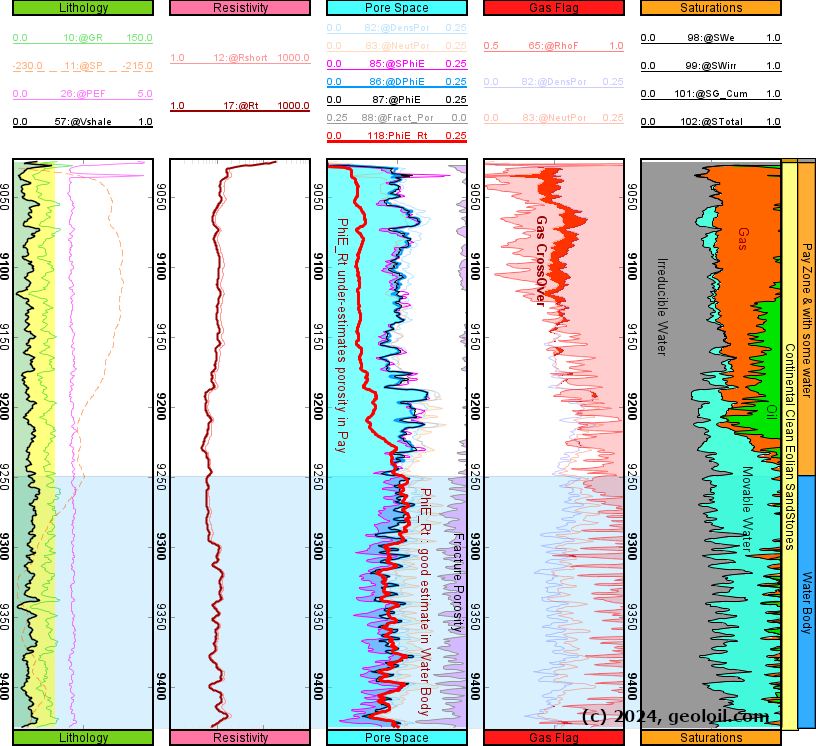
|
 Downloads
Downloads
|
 Prices
Prices
|
 Videos
Videos
|
GeolOil - How to estimate Effective Porosity from Rt Resistivity in water zones
By: Oscar Gonzalez, GeolOil LLC. This paper was first published on March 2024, on geoloil.com
Quite often there are doubts about the accuracy and reliability of porosity estimates built from classic sources like: bulk density, neutron porosity, and sonic porosity, which heavily depends on a good borehole quality without washouts or rugosity. If the formation under study has some water bodies or zones —like aquifers and water pocket compartments—, an independent porosity estimate (valid only for those water zones) calculated from the deep, not invaded true Rt resistivity curve, should be computed for validation and comparison purposes. The original implicit Simandoux water saturation equation is:

In the water zones SW=1. Hence, by rearranging the former equation and solving for φe:

In the same token, the Indonesia Poupon-Leveaux water saturation equation (which works better for fresher waters) is:

Likewise, in the water zones SW=1 must be set. Rearranging the equation and solving for φe, yields:

Notice that the former Simandoux and Indonesia porosity equations, reduce exactly to the (similarly deduced) Archie porosity equation for clean rocks when Vsh=0 and SW=1:

The Indonesia and Simandoux porosity equations can be combined into a single, weighted, more general estimate. For relatively fresh formation water salinities like NaCl = 20,000 PPM or less, prefer a w weight that favours the Indonesia equation, for instance w≅1. For saltier formations, like NaCl = 100,000 PPM or higher, prefer a w weight that favours the Simandoux equation, for instance w≅0. For other cases, intermediate values around w≅0.5 might be a good choice:
 ∎
∎
This is the equation implemented in GeolOil petrophysics software, whose computation boxes panel is shown below:

Computation panel to estimate effective porosity from Rt deep resistivity in water bodies for shaly rocks
The log plot shown below, illustrates how the effective porosity estimation equation φe (Shaly rock) behaves in a clastic eolian reservoir. The red PhiE_Rt curve of the blue Pore Space track shows the estimated effective porosity. At the bottom blue filled water body (depth > 9,250 ft), the porosity estimate has a good, accurate match with the classic effective density porosity estimate. Notice also that the secondary fracture porosity, was estimated by the difference between density porosity minus sonic porosity. The estimate is only valid in the water zone. For the shallower gas pay zone, and the transition gas-oil-water zone (depths < 9.250 ft) the porosity is grossly underestimated, loosing half or worst of the porosity value:

Log plot of a gas-oil reservoir. The Pore Space track shows in red, the estimation of effective porosity from Rt
⚠
REMARKS:
The described technique require good parameter estimates, specially for Rw formation water resistivity:
![]() Sugestion:
It is always a good idea to search for water pockets and compute the effective porosity filtered for those
water zones (even if they are thin of few feet). That would provide another reference computation for porosity,
to validate and compare against classic estimates from bulk density, sonic transit time, and neutron porosity.
Sugestion:
It is always a good idea to search for water pockets and compute the effective porosity filtered for those
water zones (even if they are thin of few feet). That would provide another reference computation for porosity,
to validate and compare against classic estimates from bulk density, sonic transit time, and neutron porosity.

|
Related articles:
|
 GeolOil is listed by the official
SPWLA software directory
GeolOil is listed by the official
SPWLA software directory
| |



|
|
|
© 2012-2025 GeolOil LLC. Please link or refer us under Creative Commons License CC-by-ND |




 TRAINING
TRAINING

 PAPERS
PAPERS
 REFERENCES
REFERENCES
 GET IN TOUCH
GET IN TOUCH

